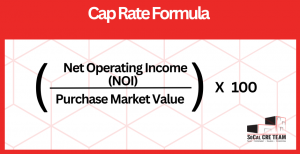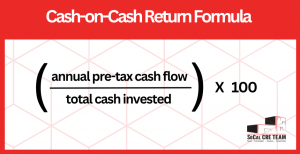Cap rate and cash-on-cash return are two of the most common metrics in commercial real estate. Keep reading to learn more about cap rate and cash-on-cash return, from the differences between these two indicators to how to calculate each of them.
What Is Cap Rate?
Cap rate is a metric that serves as an indicator of the rate of return that a commercial property is expected to generate.
To calculate the cap rate of a commercial property, it’s necessary to first understand the concept of Net Operating Income or NOI, a formula used to determine the profitability of a real estate investment.
Calculating the NOI of a property is relatively straightforward: all you have to do is to add the gross operating income and any other form of income generated by the property and then subtract the operating expenses.

Once you know the property’s NOI, you can find the cap rate by dividing it by the property’s purchase price and then multiplying the result by 100.
Let’s say, for example, that a property generates $50,000 in rental income and $1,000 in vending machine income, bringing the total income to $51,000.
The same property has operating expenses that amount to $9,600 ($1,600 in maintenance, $6,000 in property taxes, and $2,000 in insurance).
To determine the NOI of the property we just take the total income and subtract the operating expenses. In other words, 51,000 – 9,600 = 41,400.
Now, let’s say that the property in our example was purchased for $2 million. To find the cap rate, we divide the NOI by the purchase price and multiply the result by 100: 41,400 / 2,000,000 = 0.0207 X 100 = 2.07.
As you can see, the cap rate of the property in our example is %2.07
What Is Cash-on-Cash Return?
The term “cash-on-cash return” refers to the income earned by a property as a percentage of the total amount invested.
To calculate the cash-on-cash return of a property, divide the annual pre-tax cash flow for the year, divide the result by the total cash invested and multiply by 100.
The value of the annual pre-tax cash flow is obtained by adding gross scheduled rent and other income and subtracting the sum of vacancy (the number of days the property was vacant multiplied by the daily rental rate), operating expenses, and annual mortgage payments.

So, in a simplified example, imagine that you purchase a property for $200,000 and take out a mortgage with a down payment of 20% ($40,000). The monthly rental income is $4,000 but maintenance costs are $1,000 a month and you have to pay $1,000 towards the mortgage each month.
In this example, the pre-tax cash flow is $2,000 per month ($4,000 monthly rental income minus $1,000 in maintenance costs and $1,000 for mortgage), which we multiply by 12 to find the annual pre-tax cash flow, so $24,000.
No if divide that figure by the total cash investment ($40,000 mortgage down payment) the result is 0.6. All we have to do is multiply that by 100 to find the cash-on-cash return of our hypothetical property: 60%
Disclaimer: This material is for general information and educational purposes only. It is not guaranteed as to accuracy, does not purport to be complete and is not intended to be used as a primary basis for investment decisions.
What Is the Difference Between Cap Rate and Cash-on-Cash Return?
Both cap rate and cash-on-cash return are essential indicators in commercial real estate.
However, there are some key differences between cap rate and cash-on-cash return.
Cap rates serve as an indicator of the potential profit a property can generate without taking financing into account (or assuming the property was purchased all in cash).
Cash-on-cash return, on the other hand, shows the rate of return on the cash invested in a property.
While it’s hard to establish which metric is best, a sound rule of thumb is to use the cap rate at the beginning of the transaction as a quick way to determine the potential of a property.
Then, as the transaction moves forward, cash-on-cash return can be used to provide a more detailed financial picture.
SoCal CRE Team: Commercial Real Estate in Southern California
At SoCal CRE Team, we specialize in finding commercial real estate solutions for developers, investors, landlords, and tenants in the most sought-after Southern California markets such as Los Angeles, Orange County, Riverside, Anaheim, and more.
For a free commercial real estate valuation or general inquiries, contact us today by telephone (714) 456-0500 or email gary@ashwillassociates.com.




